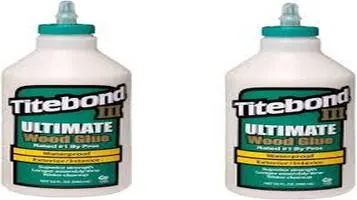The Ultimate Adhesive: A Comprehensive Review of Wood Glue
Wood glue is a specialized adhesive designed specifically for bonding wood surfaces. It is a vital tool in woodworking, carpentry, and various DIY projects, providing a strong and durable bond that can withstand stress and strain. Typically made from polyvinyl acetate (PVA) or aliphatic resin, wood glue is known for its excellent bonding properties, ease of use, and fast drying time. It penetrates the wood fibers to create a secure connection that is often stronger than the wood itself. Available in both interior and exterior formulations, wood glue can resist moisture and temperature changes, making it suitable for a wide range of applications. Its versatility, coupled with its ability to dry clear, makes it a preferred choice for both amateur and professional woodworkers.

Introduction
Wood glue is an essential adhesive for woodworkers, carpenters, and DIY enthusiasts alike. Its reliability, strength, and ease of use make it a staple in workshops and homes across the globe. With the plethora of wood glues available on the market, it can be challenging to choose the right one for your specific needs. This comprehensive review aims to delve into the characteristics, benefits, and potential drawbacks of wood glue, providing an informed perspective that will help you make the best choice for your woodworking projects.
Characteristics and Types
Wood glue is specifically formulated to bond wooden surfaces together. It is typically made from synthetic or natural polymers that create a strong, durable bond once cured. There are several types of wood glues, each with unique properties and applications:
1. PVA (Polyvinyl Acetate) Glue: This is the most common type of wood glue, often referred to as white or yellow glue. It is water-based and non-toxic, making it safe and easy to use. PVA glue is ideal for indoor projects, as it provides a strong bond but is not waterproof.
2. Aliphatic Resin Glue: Similar to PVA glue, aliphatic resin glue, commonly known as carpenter's glue, offers a stronger bond and faster setting time. It is slightly more water-resistant but is still best suited for indoor use.
3. Epoxy Glue: Comprising two components—a resin and a hardener—epoxy glue creates an exceptionally strong bond. It is waterproof and can fill gaps, making it suitable for outdoor projects and repairs.
4. Polyurethane Glue: Known for its versatility, polyurethane glue is waterproof and can bond various materials, including wood, metal, and plastic. It expands as it cures, filling gaps and providing a strong bond even in less-than-perfect conditions.
5. Hide Glue: Made from animal collagen, hide glue has been used for centuries in woodworking. It offers a strong bond and is reversible with heat and moisture, making it ideal for antique furniture restoration.
Benefits of Wood Glue
1. Strength: Wood glue provides a bond that is often stronger than the wood itself. This ensures that joints remain secure and durable, even under stress.
2. Ease of Use: Most wood glues are straightforward to apply, requiring minimal tools and expertise. This makes them accessible to both professionals and hobbyists.
3. Versatility: With different types of wood glues available, there is an adhesive for virtually any woodworking project, from indoor furniture to outdoor structures and intricate repairs.
4. Non-Toxic Options: Many wood glues, particularly PVA and aliphatic resin glues, are non-toxic and safe to handle, making them suitable for use in homes and schools.
5. Gap-Filling: Certain types of wood glue, such as epoxy and polyurethane, can fill gaps and voids in joints, enhancing the overall strength and stability of the bonded surfaces.
Drawbacks of Wood Glue
1. Setting Time: While some wood glues set quickly, others require a longer curing period. This can be a drawback for projects that need to be completed swiftly.
2. Water Resistance: Not all wood glues are waterproof. PVA and aliphatic resin glues, for example, are not suitable for outdoor projects or applications where the bonded surfaces will be exposed to moisture.
3. Expansion: Polyurethane glue expands as it cures, which can be advantageous for filling gaps but may also lead to excess adhesive oozing out of joints, requiring additional cleanup.
4. Temperature Sensitivity: Some wood glues, particularly hide glue, are sensitive to temperature and humidity changes. This can affect the bond strength and longevity in certain environments.
5. Reversibility: While hide glue is reversible, most modern wood glues create a permanent bond that can be challenging to undo without damaging the wood.
Application Tips
1. Surface Preparation: Ensure that the surfaces to be bonded are clean, dry, and free from dust and grease. Sanding the surfaces lightly can enhance the bond.
2. Even Application: Apply the glue evenly to avoid weak spots. Use a brush, roller, or applicator bottle for precise application.
3. Clamping: Clamping the glued surfaces together ensures a tight bond. Follow the manufacturer’s recommendations for clamping time to achieve optimal results.
4. Excess Glue: Wipe away excess glue immediately with a damp cloth to prevent it from drying and becoming difficult to remove.
5. Storage: Store wood glue in a cool, dry place and ensure the cap is tightly sealed to prevent it from drying out.
Conclusion
Wood glue is an indispensable tool for anyone working with wood, offering strength, versatility, and ease of use. Understanding the different types of wood glues and their specific applications can help you choose the right adhesive for your project. While there are some drawbacks to consider, the benefits far outweigh them, making wood glue a reliable and essential component in any woodworker's toolkit. Whether you're building furniture, repairing a treasured item, or crafting a DIY project, wood glue is sure to provide the strong, lasting bond you need.






